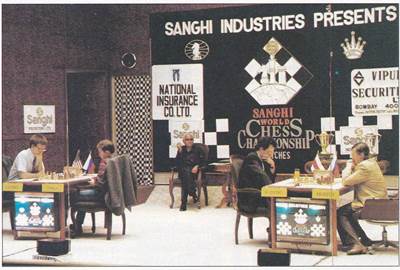Another source is a three page report in Europe Echecs, April 1995 p.8, signed 'Leontxo Garcia (WCS)'.
With the help of Google Translate, I translated Leontxo Garcia's report from the French language. He covered three topics -- the matches as a high-level chess competition, friction between FIDE & the PCA, and the behavior of the Kamskys. The report started,
February 5, 8 pm: I am still on the dangerous road which leads from Hyderabad, the capital of the state of Andhra Pradesh, to the small village of Sanghi Nagar, in the south-east of India. In the middle of August, when I had made the trip in the opposite direction at 4:30 am after the closing ceremony of the FIDE quarter-finals, I doubted that I would ever return to these exotic places. Like my colleagues, I thought it would be surprising that once Anand was eliminated, the Sanghi Industries firm continued to invest money, effort and illusions in chess.
But Ravi Sanghi, the president of the company, kept his word: "Chess deserves to be promoted, particularly in India, because it is very useful educationally, it is inexpensive and you can play without discrimination of age, sex, caste, culture, religion or social class”. This fine declaration led to a tangible result in the very great improvements made to the infrastructures and, in particular, to one of the best press centers (approximately 300 square meters) that I have seen in twelve years in the business.
Some time later, Garcia's narrative changed dramatically:-
Rustam [Kamsky] then signed a document in which he retracted his attacks against Sanghi and the organizers. But Sanghi did not calm down and declared to the Indian press that he "will never organize an event in which Gata Kamsky participates".
What happened between 'Chess deserves to be promoted' and 'I will never organize an event in which Gata Kamsky participates'? It will take another post to explain.


